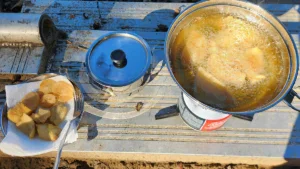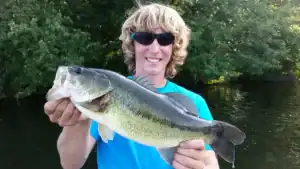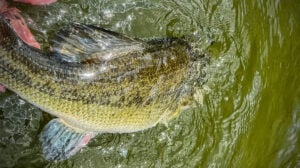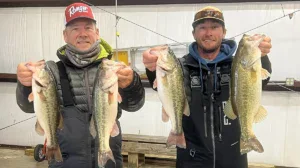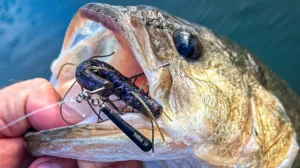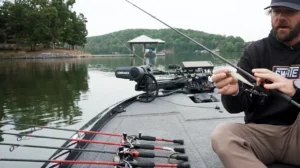Whether you’re fishing from the bank of a public lake or a farm pond, low water levels can produce some unique challenges for even the most experienced bass angler. Especially in the late summer and fall months, drought and drawdowns can suck the water right out of your favorite fishing hole and leave your favorite cover high and dry.
There are still ways to keep catching fish, though. Thanks to 100-degree temperatures and virtually no rainfall, I’ve had a lot of time to experiment with low-water scenarios over the summer and into the fall. The next time you hit the banks, keep the following tips in mind and you’ll have plenty of success.

You can get a little closer than you’re used to
If the water levels were normal and this pond were at full pool, I’d be about 10 feet further back from the shoreline in this photo. But since the water level is about five feet low, I’m not afraid to get a little closer than I normally would.
It’s essential to remember that bass tend to move with the water level. I know I harp on that a lot, but it’s something we all need to remember. So with this low water, I don’t expect the bass to be right up on the bank. I actually walked the bank looking for signs of life, whether it be bluegill, small crappie or shad and I found absolutely nothing other than a snapping turtle. That told me that the party was going on in a little deeper water, so I wasn’t really afraid of spooking anything in the shallows.
It can be important to get a little closer to the shoreline because a lot your traditional cover is going to be out of the water, meaning you’ll have to make longer casts to dissect any sunken trees, depth changes or submerged vegetation.

Pay close attention to casting angles
Take a close look at this photo and you’ll notice two very important things: the old water line on the bank and the placement of my cast. Even though some of that shoreline grass looks good, I’m casting 10 or 12 feet in front of it.
Remember the whole “bass move with the water level” thing? Yep. I’m bringing it up again.
If your bank fishing area is void of cover in low-water situations, these types of casts can be a huge deal. Bass will often sit on the first depth change away from the bank. I call these “break lines” (I wrote an entire article explaining them) and they’re probably the most overlooked aspect among bank anglers. They’ll sit on these little stair step-like depth changes for several reasons.
- They can still corral bait in the shallows if necessary.
- Break lines offer a heightened sense of security from airborne predators.
- Bass will travel along these break lines.

It’s awfully tough to beat a topwater lure
When I’m faced with low water from the bank, I rely on two techniques pretty much all of the time: a wacky-rigged stick worm and some type of topwater lure. I’ve found that, when the water level drops, bass tend to suspend in the water column. In other words, they’re between the surface and the bottom, just hanging out somewhere in the middle.
Because a bass’ tendency is to feed upward, I want something a suspended bass can easily ambush. As long as the water is over 55 degrees, you have a great chance of catching a giant on a topwater. My personal favorites are a soft-plastic toad or a hollow-bellied frog.
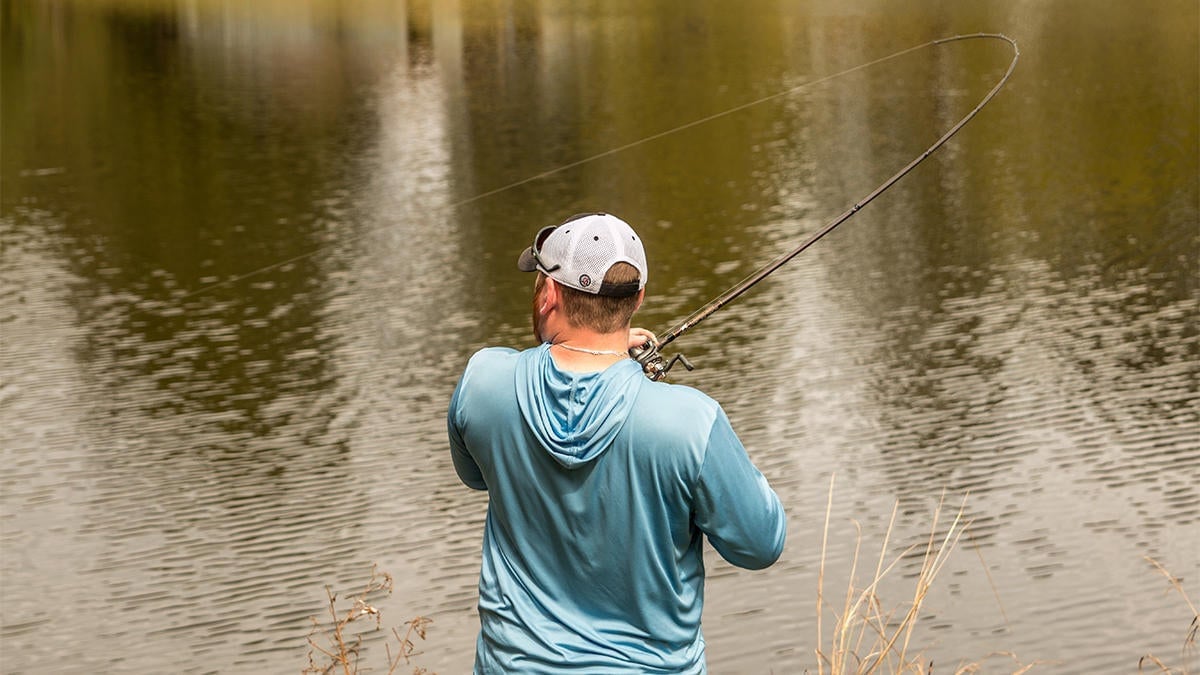
Repeated casts may be necessary
In my opinion, low water can put bass in a weird hangover-type of mood. I don’t really know why, but they can just become flat-out lethargic when the bottom gets sucked out. That’s why it’s so important to make repeated casts to good-looking cover. It’s one of the rare times it’s actually good to be a stubborn angler.
I caught my personal-best bass, a 13-pounder, in low-water conditions from the bank (more on that here). I was actually talking to my buddy, mindlessly flipping to the same laydown for about 20 minutes. I didn’t expect to catch anything. But on what seemed like the 100th flip, that 13-pounder bit. This proved the importance of repeated casts to me.
Bass don’t always bite out of hunger. Sometimes you have to tick ’em off and make them bite out of aggression.
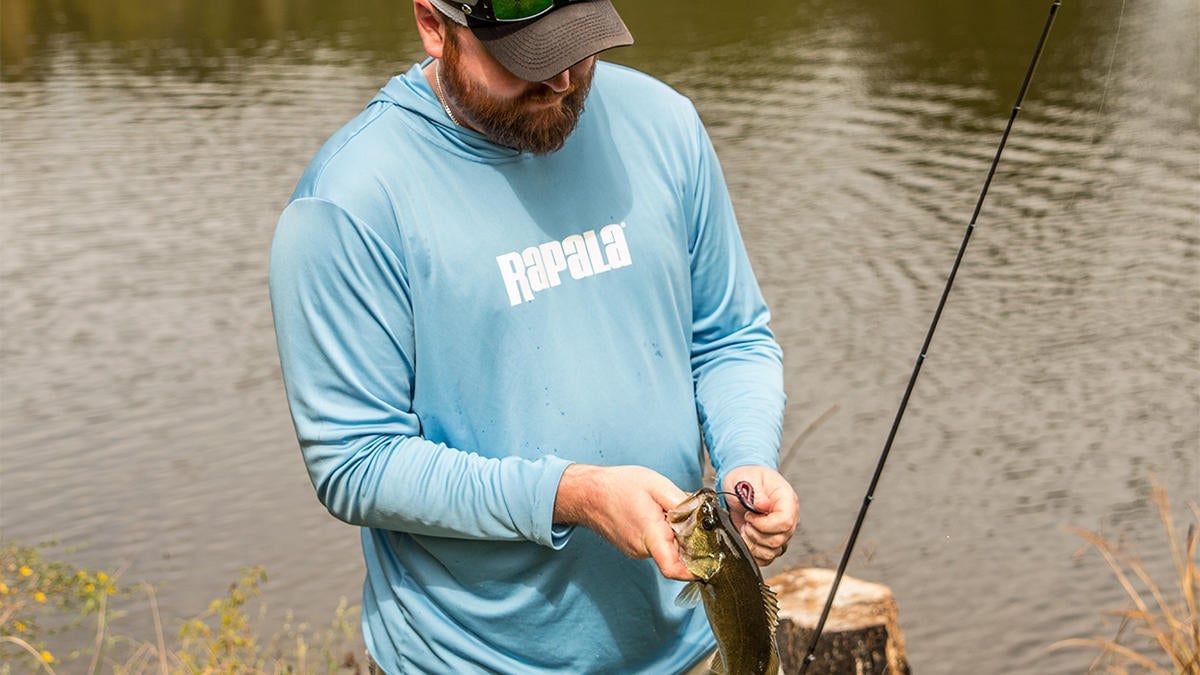
Where there’s one, there’s more
I know, I know. This isn’t a very impressive bass. But it illustrates my point that, when you get one bite in an area, you need to unhook it fast and get your bait back in there as fast as you can. There are probably several more in the exact same spot.
When my wife and I were shooting photos for this article, I caught a dozen or so bass off of a single laydown. When the water level drops and cover becomes scarce, whatever cover is left in the water becomes prime real estate for bass. Essentially, the bass become concentrated and this creates competition. Competition creates aggressive bass which makes for a happy angler!
It can still be tough to get that first bite, as we discussed earlier. But once you do, pay close attention to exactly where the bite happened and take advantage of the competitive bass in the area.
Don’t let low-water conditions hamper your bass fishing. It takes a little getting used to, but I promise these tips will help you have more success. Bookmark this article because no matter the time of year, these tips are applicable. Good luck!


